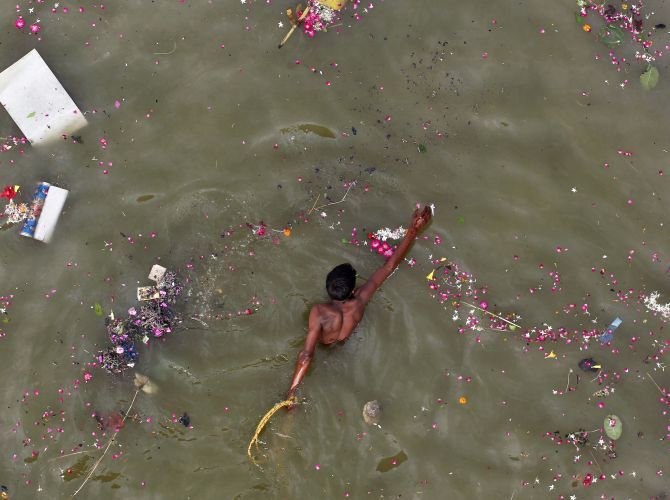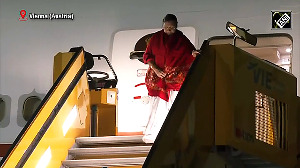If the Ganga manages a rebirth, so will the country, observes Subir Roy

The strategy to clean up the Ganga is disarmingly simple and can be expressed in two sentences. One: don’t kill the river. Two: don’t dump waste (solid and liquid) in it. This needs keeping in mind to ensure success for Namami Gange, the official plan to clean up the sacred river, which has just been sanctioned Rs 20,000 crore of central funds to be spent over five years.
Its one big plus is that official sources claim they have learnt from past mistakes that have resulted in the Ganga Action Plan, launched in 1985, having so little to show for itself despite spending Rs 4,000 crore. The primary learning is that the programme cannot succeed unless local stakeholders are involved in giving it shape and see themselves gaining from it. The plan is to involve a hierarchy of interests -- riverfront stakeholders, local bodies and state governments.
Waste removal may well go up to a point, but right now, the critical threat to the river comes from continuing with hydropower projects envisaged in the upper reaches and, after the dams are already built, a startling notion of having a barrage across the river after every 100 km. Such projects will impede and severely damage the flow of the river when a critical element in rejuvenating it is to have a steady flow that will cleanse the filth lower down the river. Once dirt and toxicity are flushed out, ecological life in and around the river will make a steady comeback. In fact, many voices, including those of religious leaders, have spoken of the paramount need to have an aviral pravaha (uninterrupted flow) as an essential prerequisite for saving the river. This has to go with ensuring that fresh waste is not put into the river.
Saving the Ganga is a gigantic and hugely intricate task. Coming to grips with it goes to the heart of the way we have been running the country and should not be. There is not even a clear understanding of the extent of the problem.
The Ganga is not one river but many, with numerous tributaries. It does not cover just 2,500-odd km but, including tributaries, 25,000 km. How can you clean up the Ganga if its tributaries keep polluting it? And how will you remove the pesticides, used in agriculture, brought into the Ganga by its tributaries? There will be a political crisis if you try to change an ingrained agricultural practice like use of pesticides in five years.
The first and the most important task is to stop having more projects in the upper reaches of the river that severely change its character and damage it. Himanshu Thakkar of the South Asian Network on Dams, Rivers and People has pointed to two expert committees recommending that 24 of the 70 hydropower projects in the Alaknanda-Bhagirathi basin be dropped as they will do irreversible damage to aquatic and terrestrial biodiversity, but the ministry of environment is leaving no stone unturned to be able to carry on with them.
In fact, after the Uttarakhand disaster, it is vital to revisit all the existing, under-construction and planned projects in the entire basin so as to stop doing what adversely affects the headwaters of the Ganga. Water withdrawal by hydropower plants has put the ability of the river, even in its higher reaches, to rejuvenate itself under threat.
A major setback to the Ganga has been the construction of the Farakka barrage that has not served the original purpose (rejuvenating the Kolkata port) and has harmed people both living upstream (rising salinity) and downstream (bank erosion). Yet Union minister Nitin Gadkari has come up with the horrendous suggestion of building barrages down the entire stretch of the river at 100-km intervals.
Another important way to ensure that the river has adequate flow is to revisit the way canals at three places -- Bhimgoda, Bijnor and Narora -- are taking away almost all the water flow at those points for irrigation. At least, some of this water has to be left in the river. Trying to cut in five years the use of Ganga water in agriculture accessed through established irrigation systems will create a political crisis. Even if you succeed and have a river worth the name, you have to define a pathway for the river, mark out the route along which it will flow so as to be able to carry all the silt and flood waters. Once this is done, encroachments along the river will automatically fall foul of the law.
After ensuring an adequate flow, comes the task of ensuring that waste -- solid and liquid -- does not get into the river. At the last count, 36 class-I cities and 764 industrial units dump their sewer and toxic industrial waste into the river.
The Central Pollution Control Board, which studied 404 units, found that all but 23 did not comply with pollution control rules. Most of the effort under the Ganga Action Plans has gone into redesigning sewer systems and setting up sewage treatment plants to take care of liquid waste getting into the river.
This had given the effort so far a civil engineering, public works department project-driven top-down approach, says Vijay Jagannathan, a water resources expert. But you need to get people involved, so that at the least crematoriums are used and half-burnt bodies are not dumped into the river. If the Ganga manages a rebirth, so will the country.
Image: A man searches for coins thrown by devotees as religious offerings in the Ganga. Photograph: Jitendra Prakash/Reuters











 © 2025
© 2025